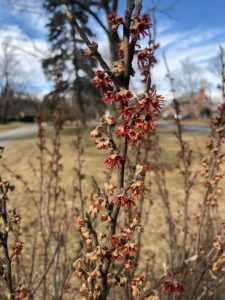No, it’s not forsythia! It’s festive and fragrant deciduous witch hazel, showering sun even in snow, and often confused with that unrelated shrub.
“Witch” is from “wiche” – or “flexible” in Old English, hazel from the semblance to hazelnut. Fall and winter-into-spring varieties bloom in our area. You can find two native and one cultivar witch hazels on the Boulevard, just across the path from the Witherby statue. The fragrant flowers of native witch hazel are yellow, while cultivars range from light yellow to coppery. In fall, the foliage runs the gamut, fiery to buttery to citrusy.
The fruit, dried on the branch, ejects seed for offspring.
One February-into-March variety is Arnold’s Promise, with specimens in our area, rising to fifteen feet and clumping, with curly hair-ribbon fronds. It was introduced by Arnold Arboretum in Boston after being hybridized by bees. See https://arboretum.harvard.edu/stories/the-ultimate-early-bloomer/.
Native Americans used forked limbs of witch hazel as dowsers to search for water, according to the U.S. Forest Service. Whether or not it can fill your glass, it may make your heart brim with gratitude for winter’s ebbing.
Betsy Shea-Taylor




